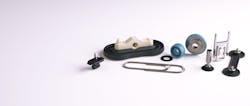What’s the Difference Between Strain Gauges? (.PDF Download)
When designing an experiment or test, simplicity is important. Each process added to a test or experiment to obtain data increases the potential for error. For destructive testing or experiments, getting as much information out of a sample is desirable to limit the amount of parts needed. Hooke’s Law has been around since 1678. It defined the relationship between stress put on a material and the resulting deformation. This article will cover the past, present, and future technology that has been used to measure this law.
Past
Mechanical strain gauges: Like many early designs, the first strain gauges were analog. Mechanical devices like springs and levers are still used today, but these early models weren’t very accurate. The force needed to cause a shift in the measurement—often called force of shift—tended to be high. One example to lower the force to displace an indicator was filed on March 14th 1939. The A.U. Huggenberger Strain gauge was to provide an improved extensometer that worked in one continuous operation. The goal of the inventor, Arnold Huggenberger, was to keep the force of shift as small as possible to improve the device’s accuracy and sensitivity.








